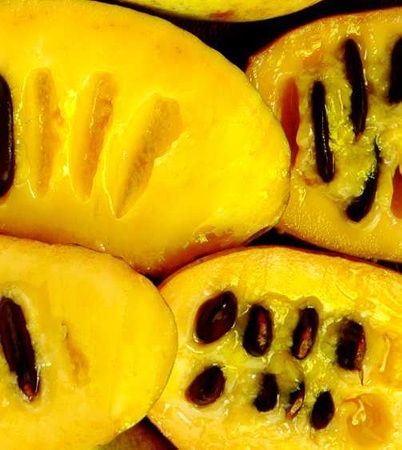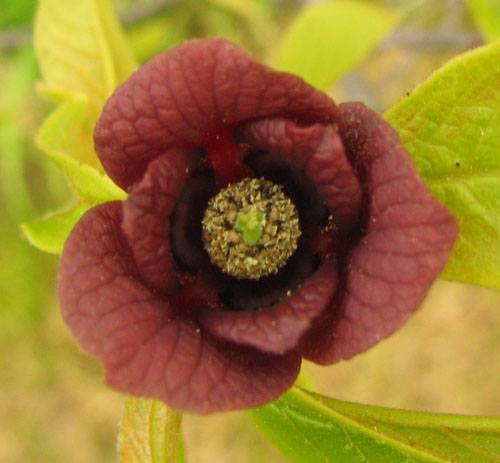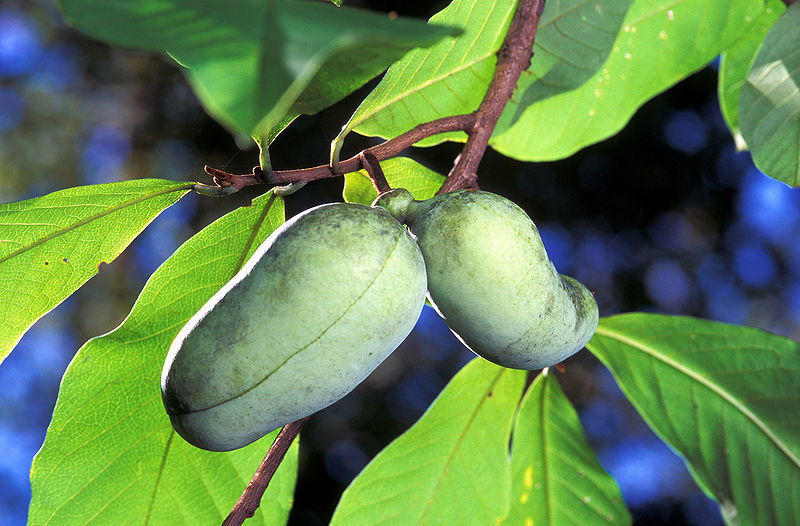American Pawpaw Tree: A Forgotten Member Of The Custard Apple Family of Plants That Loves Freezing Winters!
Asimina triloba
Pawpaws are the largest native fruit to North America. The Pawpaw tree belongs to the Annonaceae family of plants -- the Custard Apple family.
Other Annonaceae include sugar apples, soursop, cherimoya, and atemoya. The genus Asimina is found in the more temperate zones.
It has a tropical flavor something like a combination of banana, mango & pineapple all rolled into one. Various cultivars will resemble one of those flavors over another.
Research and development of cultivars of pawpaw is still in its infancy.

typical pawpaw fruit inside:
Seeds are 1/2 to 1.5 inches long,
and vary in quantity according to the cultivar.
GROWTH & HABIT
Pawpaws are native to the temperate climate of eastern North America and tolerate humidity well. They require at least 400 chill hours and are cold hardy to at least -20F. They are hardiest in zones 5-8, including the northern half of Alachua County (8b). It is reportedly growing well in the San Jose area also, which is zone 9. Reference here.
Pawpaws grow to about 20' high max, and about 3/4 as wide as it is tall. Trees should be planted a min 10' apart, but no more than 30' apart for best pollination. Pawpaws are not self-fertile so you need 2 different cultivars for pollination if grafted, or two seedlings of any cultivar. Bees rarely pollinate: it is usually up to the flies & beetles to pollinate the pawpaw.
Pawpaws grow best in full sun, though they will tolerate some shade. Expect a reduced harvest if grown in partial shade.
That said, young plants are sensitive to full sun and prefer filtered sun for the first year or two.

photo courtesy wikipedia
Bare root stock is best planted in the spring, but container grown stock can be planted anytime during the growing season. They prefer rich, loamy, fertile soils with moderate acidity to neutral pH in the range of 5.5-7.0. They naturally thrive with a mulching layer of decomposing leaves on top of the soil.
Young trees can grow as much as 5' in just 3 months, under greenhouse conditions. The dark green foliage can be as much as 12" long, giving the pawpaw an interesting tropical look. They turn yellow in the autumn and trees are bare for the winter. In late spring, blossoms appear first, then the leaves.
They require at least 30 inches of annual rainfall, mostly in the spring & summer. Not drought tolerant, but definitely require good drainage.
FRUITING
Pawpaws are one of the last trees to leaf out in the spring. Their deep orange-maroon velvety flowers appear in the spring, and fruit ripens in the fall from late August to mid-October. Fruit is often clustered on the tree, up to 9 in a cluster.
Fruit naturally falls from the tree when ripe, but may be picked slightly under-ripe and be ripened indoors. Do not pick too early or they will not ripen fully. A good sign of impending ripening is a slight softness much like a peach. They release large quantities of ethylene when ripening.
The fruits of the Pawpaw are highly perishable and do not ship well. Size of fruit varies from a small 4-6oz to over a pound, depending on the cultivar. Pawpaw are usually 3-6" long, nearly the size of a small papaya or mango.
Skin color on the fruit can vary from green to yellow, and sometimes gets dark flecks, much like bananas. Fully ripe fruit only lasts a few days, up to a week in the refrigerator. If picked slightly unripe, fruit will last a few weeks in the refrigerator, and then allowed to finish ripening at room temperature. Pulp can also be pureed and frozen for later use.

Pawpaw fruit has a high nutritional value, exceeding that of apples, peaches, and grapes in vitamins, minerals, and amino acids. They contain all of the essential amino acids. REFERENCE: KSU table here.
CULTIVARS
There are more than 45 named cultivars. Some are propagated as seedlings, others are grafted to maintain tight reproduction standards and faster fruiting. None are reliably self fertile yet. Two seedlings will pollinate each other, but if using grafted stock, it takes two different cultivars to pollinate.
Southern cultivars are more likely to produce if you're experimenting in zone 9a, the southern edge of their growing range.
A complete list of named cultivars is maintained by Kentucky State University. They manage the only full time pawpaw research program in the world, and maintain the gene bank for pawpaws for the USDA.
Find the KYSU website here: KYSU website
The latest research includes 6 premium grafted varieties by Neil Peterson found here.
We favor these 3 cultivars of Pawpaws for growing in North Florida: Mango, Susquehanna, & a native Southern seedling.
For most insect issues and topical mold issues,
there's always Organocide.
PESTS
The bark and seeds are naturally high in acetogenins, compounds that are poisonous to most insects & some fungi. However, larvae of the Zebra Swallowtail Butterfly love to eat the leaves.
The Pawpaw Peduncle Borer is a small native moth whose larvae attack the flowers, killing the flowers.
Leafspot can occur from various fungi. Sooty mold & flyspeck can mar the fruit skins. Soil nutrient imbalances can lead to black fungus rot of the ripening fruit.
For systemic mold issues, fix your soil bacteria: cultivate the earthworm factory below ground!
Any amount of synthetic chemicals above ground -- granular or sprays -- will kill your earthworms below ground, causing soil bacteria imbalances that can result in systemic fungi / bacteria issues in the tree.
OTHER USES FOR PAWPAW
More pawpaw research can be found here: http://www.pawpawresearch.com/index.html
According to research done at Purdue by Dr. McLaughlin, and funded by the National Cancer Institute, about 50 acetogenins were found in the pawpaw, and only about 30 in the graviola (aka soursop).
Read more: http://www.pawpawresearch.com/graviola-inferior.html


